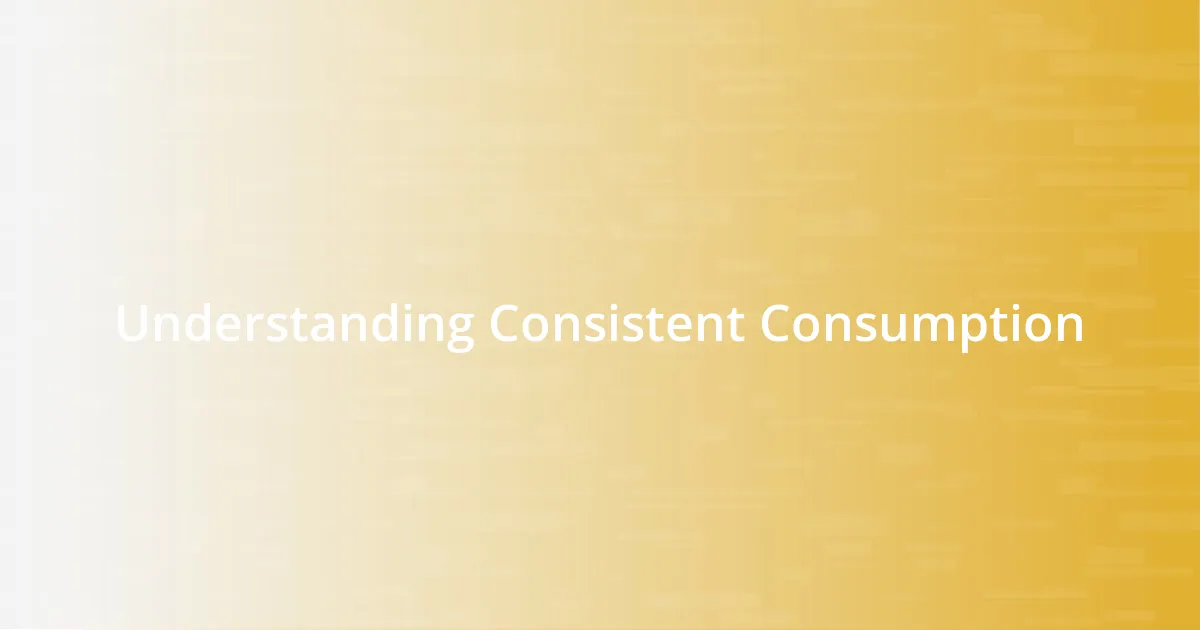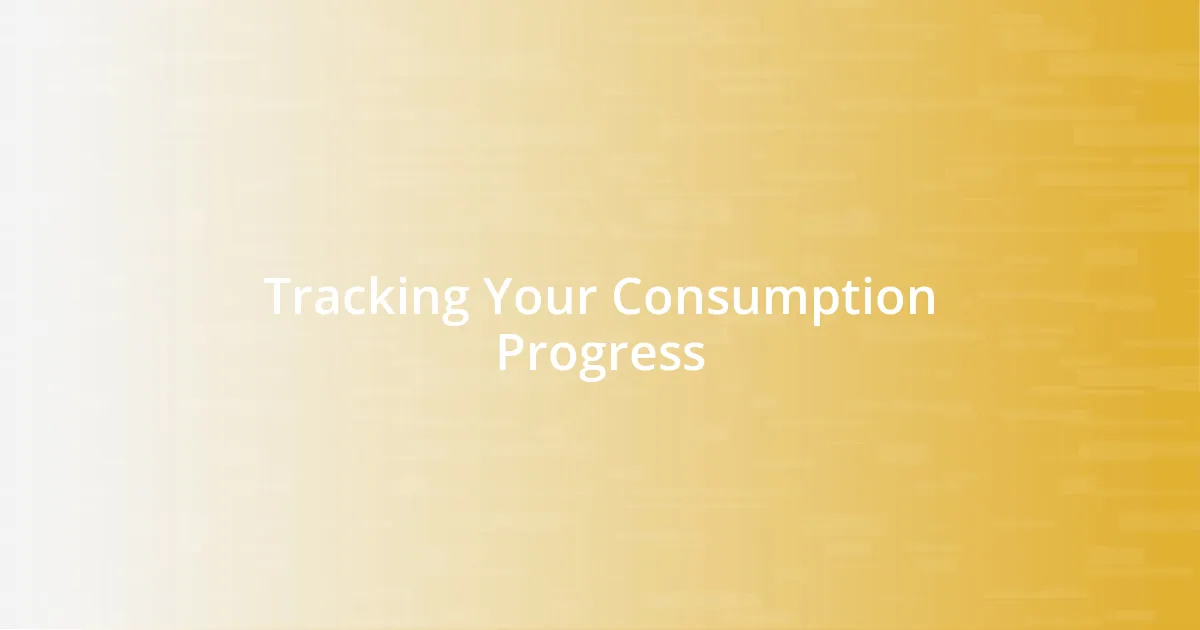Key takeaways:
- Consistent consumption requires aligning habits with personal values and understanding emotional triggers that influence eating behavior.
- Setting clear, specific, and measurable consumption goals helps track progress and maintain motivation.
- Creating a sustainable routine involves balancing structure and flexibility, with regular adjustments to accommodate life changes.
- Celebrating small wins reinforces positive behavior and enhances motivation, with community support amplifying the joy of achievements.

Understanding Consistent Consumption
Consistent consumption is about establishing a reliable rhythm in our daily habits, but it often feels more like a marathon than a sprint. I remember the early days of my own journey when I would start strong, only to falter after a few weeks. It made me wonder, what’s the secret sauce that allows some to maintain their momentum?
When I really delved into understanding consistent consumption, I realized it’s more than just discipline; it’s about aligning your habits with your personal values and lifestyle. For instance, I used to struggle with nutrition until I discovered that preparing meals I genuinely enjoyed made all the difference. Have you ever thought about how your environment shapes your consumption patterns?
Emotions play a huge role in this journey too. I often find that when I’m stressed or overwhelmed, I tend to revert to old, less consistent habits. Reflecting on this, I ask myself: What can I do to transform these emotional moments into opportunities for growth rather than setbacks? Together, these layers of understanding create a clearer picture of what consistent consumption really means in our lives.

Defining Your Consumption Goals
Setting clear consumption goals is a crucial first step toward consistency. In my experience, it’s essential to define what success looks like for you. I recall a time when I simply aimed to “eat healthier” without concrete targets. This vague goal led to confusion and inconsistency, so I shifted my focus to specific actions, like incorporating three servings of vegetables in my meals each day. This change not only made my goals more tangible but also helped me track my progress effectively.
To refine your consumption goals, consider these key aspects:
- Specificity: Define exactly what you want to achieve.
- Measurability: Ensure your goals can be tracked over time.
- Attainability: Set realistic targets that challenge you but are still achievable.
- Relevance: Align your goals with your personal values and lifestyle.
- Time-Bound: Establish a timeline to reach your objectives.
By incorporating these elements, I found that my path became clearer, and my experiences grew richer. Each milestone achieved felt rewarding and reinforced my commitment to consistent consumption. It’s like each small victory fuels the next, motivating us to keep moving forward.

Identifying Your Consumption Triggers
Identifying your consumption triggers is crucial for maintaining consistency. I often find that my triggers can be environmental or emotional. For instance, walking past my favorite bakery can lead to an impulsive decision to indulge, even when I’ve planned my meals. Recognizing these situations has been a game-changer for me. Have you observed similar patterns in your life?
A fascinating aspect of triggers is how intertwined they are with our emotions. When I’m feeling anxious, I’ve noticed an urge to snack mindlessly. This understanding prompted me to create healthier coping mechanisms, like going for a walk or meditating, which helps divert me from that emotional eating. What coping strategies resonate with you when faced with triggers?
Mapping out my triggers has allowed me to create a clearer picture of my consumption habits. A simple exercise I recommend is journaling about when and why you consume. This reflective practice can reveal insights that make your triggers more manageable. By keeping a record, you can begin to see patterns emerge, guiding you towards smarter consumption choices.
| Type of Trigger | Example |
|---|---|
| Environmental | Walking by a bakery. |
| Emotional | Eating when feeling stressed. |
| Social | Consuming snacks at a friend’s party. |
| Habitual | Regular coffee break at work. |

Creating a Sustainable Routine
Creating a sustainable routine requires a thoughtful balance between flexibility and structure. I typically plan my meals at the beginning of each week, allowing me to streamline grocery shopping and meal prep. This habit not only saves time but also keeps me from making impulsive food choices. Have you ever tried meal prepping? It can be surprisingly liberating to know precisely what you’ll be eating every day.
In my journey, I learned the importance of creating a consistent schedule. I’ve found that setting designated times for meals and snacks helps me avoid unnecessary grazing throughout the day. I remember when I used to skip breakfast, thinking I was saving calories, but that only led to binge eating later. By nurturing a routine where every meal is intentionally planned, I feel more in control and satisfied. How about you? Are there particular times that work best for your eating habits?
Another pivotal aspect is adapting your routine over time. Life changes — work schedules, social commitments, or even personal growth. I experienced this firsthand when I changed jobs. My old eating habits no longer suited my new lifestyle. I reassessed and adjusted my routine to fit my new schedule. It’s vital to remain aware and make informed adjustments to ensure our routines support our goals, rather than hinder them. How have you adapted your routine during significant life changes?

Tracking Your Consumption Progress
Tracking my consumption progress is one of the most enlightening parts of my journey. I’ve discovered that keeping a food diary can be a powerful tool. Writing down everything I eat, along with my feelings at the time, helps me identify patterns and triggers that I might have otherwise overlooked. Have you ever realized just how much your emotions influence your consumption habits?
I use a blend of apps and traditional journals to track my progress. One app allows me to scan barcodes of the foods I consume, making it incredibly simple to log my meals. I remember when I first started using it; I was shocked to see how quickly my calorie count added up without me even noticing. Tracking not just quantity but also the quality of what I consume has guided me toward healthier decisions in real-time. How do you keep an eye on what you consume?
Beyond just tracking, I find it essential to analyze my logs regularly. At the end of each week, I review my notes and reflect on what worked and what didn’t. It’s a mix of data analysis and emotional reflection. Recently, I noticed that on days I felt stressed, my snacking increased significantly. This insight prompted me to find other outlet strategies for my stress, leading to more mindful evenings. Have you conducted a similar reflection? The process can be eye-opening and incredibly rewarding.

Adjusting Strategies for Consistency
Adjusting my strategies for consistency has always felt like a dance rather than a rigid formula. For instance, I used to strictly adhere to a fixed meal plan, but after noticing how it sometimes left me feeling restricted, I decided to incorporate more flexibility. I began allowing myself to swap meals based on my cravings or seasonal ingredients, which made eating feel much more enjoyable. Isn’t it refreshing when you can still stick to your goals while savoring the journey?
As I continued to evaluate my habits, I realized that consistency didn’t mean perfection; it was more about finding the rhythm that felt right for me. There were weeks when unexpected events derailed my plans, but I learned to embrace those moments. If I missed a workout or strayed from my meal plan, I’d pivot instead of crumbling. For example, I recall a weekend where a friend’s surprise visit meant pizza instead of my planned salad. Instead of letting that throw me off completely, I enjoyed the pizza and resumed my healthy choices after. Does that resonate with you? Have you found ways to enjoy those slip-ups and move forward?
Moreover, I’ve discovered that revisiting my goals regularly keeps me aligned with my vision. Each month, I set aside time to assess what’s working and what needs a tweak. Recently, I noticed that I was growing tired of my usual snacks, which made me less enthusiastic about sticking to my routine. So, I swapped my standard almonds for a colorful assortment of fresh fruits and nut butter. It reignited my enthusiasm for healthy eating! How often do you give yourself the chance to rethink your strategy? It’s like breathing new life into an old plan.

Celebrating Small Wins and Milestones
Celebrating small wins and milestones has become my favorite part of the journey. I remember the first time I hit my daily water intake goal; it felt like a victory dance moment! Reflecting on those seemingly tiny achievements boosts my motivation and reminds me that progress comes in many shapes and sizes. Have you taken a moment to celebrate your own little victories recently?
Every time I finish a week with balanced meals or hit a new fitness goal, I treat myself to something special—like a new book or a cozy night in with a film I’ve been meaning to watch. This not only makes the journey enjoyable but also reinforces positive behavior. It’s fascinating how acknowledging these milestones can create a ripple effect, encouraging me to aim for even bigger goals. What would your “celebration” for a small win look like?
I’ve learned that sharing these small victories with friends or family amplifies their joy. One time, after successfully cooking a healthy recipe I had been nervous to try, I shared the outcome with my best friend over a video call. Her excitement was contagious, and it motivated me to keep exploring new dishes. Conversations like this make me realize the importance of community in our journeys. How do you share your progress with those around you? There’s something truly enriching about celebrating together.














